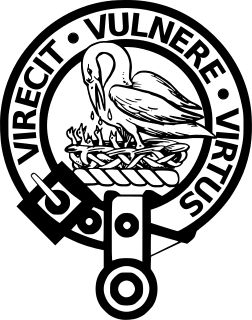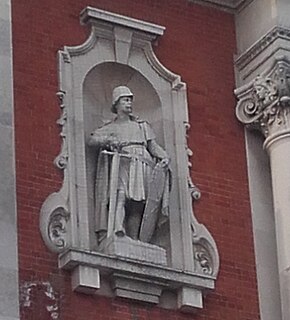Related Research Articles

Henry III, also known as Henry of Winchester, was King of England, Lord of Ireland, and Duke of Aquitaine from 1216 until his death in 1272. The son of King John and Isabella of Angoulême, Henry assumed the throne when he was only nine in the middle of the First Barons' War. Cardinal Guala declared the war against the rebel barons to be a religious crusade and Henry's forces, led by William Marshal, defeated the rebels at the battles of Lincoln and Sandwich in 1217. Henry promised to abide by the Great Charter of 1225, a later version of the 1215 Magna Carta, which limited royal power and protected the rights of the major barons. His early rule was dominated first by Hubert de Burgh and then Peter des Roches, who re-established royal authority after the war. In 1230, the King attempted to reconquer the provinces of France that had once belonged to his father, but the invasion was a debacle. A revolt led by William Marshal's son, Richard Marshal, broke out in 1232, ending in a peace settlement negotiated by the Church.

Richard, second son of John, King of England, was the nominal Count of Poitou (1225–1243), Earl of Cornwall and King of the Romans. He was one of the wealthiest men in Europe and joined the Barons' Crusade, where he achieved success as a negotiator for the release of prisoners and assisted with the building of the citadel in Ascalon.

White Castle, also known historically as Llantilio Castle, is a ruined castle near the village of Llantilio Crossenny in Monmouthshire, Wales. The fortification was established by the Normans in the wake of the invasion of England in 1066, to protect the route from Wales to Hereford. Possibly commissioned by William fitz Osbern, the Earl of Hereford, it comprised three large earthworks with timber defences. In 1135, a major Welsh revolt took place and in response King Stephen brought together White Castle and its sister fortifications of Grosmont and Skenfrith to form a lordship known as the "Three Castles", which continued to play a role in defending the region from Welsh attack for several centuries.
Peter de Rivaux or Peter de Rivallis was an influential Poitevin courtier at the court of Henry III of England. He was related to Peter des Roches, being a nephew.
Richard de Clare, 5th Earl of Hertford, 6th Earl of Gloucester, 2nd Lord of Glamorgan, 8th Lord of Clare was son of Gilbert de Clare, 4th Earl of Hertford and Isabel Marshal. He was also a powerful Marcher Lord in Wales and inherited the Lordship of Glamorgan upon the death of his father. He played a prominent role in the constitutional crisis of 1258–1263.

Beatrice of England was a member of the House of Plantagenet, the daughter of Henry III of England and Eleanor of Provence.

Clan Stewart is a Scottish Highland and Lowland clan. The clan is recognised by Court of the Lord Lyon; however, it does not have a Clan Chief recognised by the Lord Lyon King of Arms. Because the clan has no chief it can be considered an armigerous clan; however, the Earls of Galloway are now considered to be the principal branch of this clan, and the crest and motto of The Earls of Galloway's arms are used in the Clan Stewart crest badge. The Court of the Lord Lyon recognises two other Stewart/Stuart clans, Clan Stuart of Bute and Clan Stewart of Appin. Clan Stuart of Bute is the only one of the three clans at present which has a recognised chief.

Otto de Grandson, sometimes numbered Otto I to distinguish him from later members of his family with the same name, was the most prominent of the Savoyard knights in the service of King Edward I of England, to whom he was the closest personal friend and many of whose interests he shared.
Events from the 1260s in England.
Events from the 1220s in England.

Eudo Dapifer ;, was a Norman aristocrat who served as a steward under William the Conqueror, William II Rufus, and Henry I.
Louis I was the Baron of Vaud. At the time of his birth he was a younger son of the House of Savoy, but through a series of deaths and his own effective military service, he succeeded in creating a semi-independent principality in the pays de Vaud by 1286. He travelled widely in the highest circles of European nobility, obtained the right to mint coins from the Holy Roman Emperor, and convoked the first public assembly in the Piedmont to include members of the non-noble classes. When he died, his barony was inherited by his son.

William II de Cantilupe, 2nd feudal baron of Eaton Bray in Bedfordshire, was an Anglo-Norman magnate.

Robert Walerand, was Justiciar to King Henry III (1216–1272). He was throughout his reign one of the king's familiares. Among the king's household knights he stands in the same position as his friend John Mansel among the royal clerks. Walerand was most notably employed by the king in the ill-fated scheme of raising money from the barons for his second son Edmund to take up the crown of Sicily, offered by the Pope in 1254. His forceful exactions in that connection were one of the causes of the rebellion of Simon de Montfort and the Barons' War, which ended however with royal victory at the Battle of Evesham in 1265. His principal residence was Siston, Gloucestershire.

Chenaux Castle is a castle in the municipality of Estavayer-le-Lac of the Canton of Fribourg in Switzerland. It is a Swiss heritage site of national significance.

Edward I of England was associated with a faction of nobles and knights who came from the County of Savoy, and were favoured in England. Savoy became linked to the Plantaganet monarchy of England with the marriage of Edward I's parents Henry III of England and Eleanor of Provence in 1236. Eleanor of Provence was the daughter of Beatrice of Savoy.

Ebulo de Montibus Born as a younger son of Ebal I de Mont and his wife, Beatrice, Ebal II was first noted in 1237. Born in the Pays de Vaud, now Switzerland then Savoy. The Famille de Mont held the castle at Mont-le-Grand near Rolle. Better known in English records as Ebulo de Montibus, Ebal II de Mont had travelled to England by 1246. A household knight of King Henry III of England, granted much land in England. By 1256 he was part of the Savoyard circle of the Lord Edward, later King Edward I of England. Recorded as a Steward in the household of King Henry III of England from 12th November 1256 until 26th May 1263. A witness for King Henry III at the Mise of Amiens, where he swore for the king's good conduct in accepting King Louis XIVs arbitration. Left England during the Second Barons' War with Queen Eleanor of Provence and Peter II, Count of Savoy and active in attempting to raise an army loyal to the crown. Rewarded for his loyalty by being made Constable of Windsor Castle.

Pierre de Champvent was a noble originally from Savoy who made a career as a military and courtier in England.

William of Champvent or Guillaume de Champvent was the son of Henri, Lord of Champvent, brother of Othon de Champvent and Pierre de Champvent, cousin of Otto de Grandson. He followed Peter II, Count of Savoy to England and served King Henry III of England as a diplomat. His church career in England, being a dean of St. Martin's Le Grand in London from 1262. His influence at court in 1262 is evidenced by his joining the Savoyard witness list for a charter relating to Queen Alianor’s dowry. Upon his departure back to Lausanne Edward I of England would appoint Louis I of Vaud to St. Martin's Le Grand

Peter of Geneva or Pierre de Genève was the son of Humbert de Genève, Count of Geneva and grandson of William I.
References
- ↑ E. B. Fryde, D. E. Greenway, S. Porter & I. Roy. (Eds) 1986. Handbook of British Chronology.Third ed. London: Offices of the Royal Historical Society.
- ↑ Michael Ray. 2005. Three Alien Royal Stewards in Thirteenth-Century England: The Careers and Legacy of Mathias Bezill, Imbert Pugeys and Peter de Champvent. Boydell and Brewer, 51-68.
- ↑ Jean-Pierre Chapuisat. 1964. Au service de deux rois d’Angleterre au XIIIe siècle: Pierre de Champvent. Revue Historique Vaudoise 72: 163.
- ↑ David Carpenter. 2020. Henry III : The Rise to Power and Personal Rule 1207 - 1258. New Haven: Yale University Press. 360